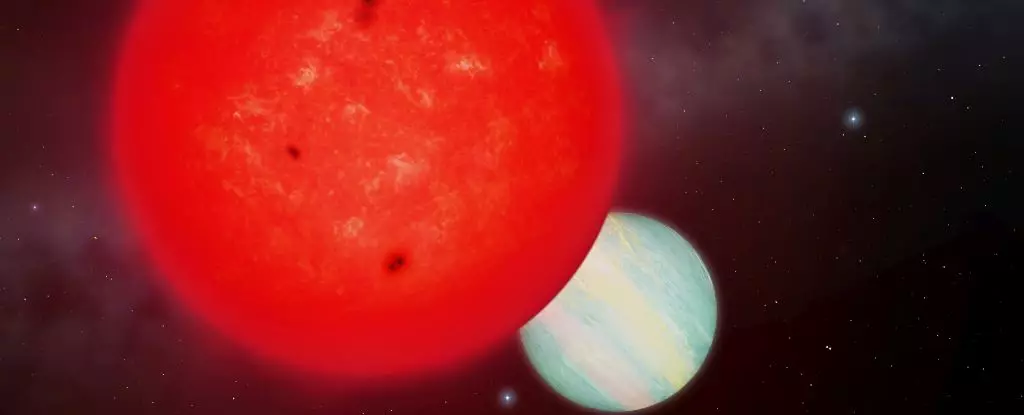The cosmos is full of surprises, and the recent discovery of TOI-6894b is a stunning testament to this fact. As astronomers expand their explorations beyond familiar frameworks, they discover phenomena that challenge long-held beliefs about star and planet formation. Orbiting a diminutive red dwarf star, TOI-6894b—a gas giant roughly the size of Saturn—has emerged from theories that seemed unassailable. This exoplanet, with a radius close to 86 percent that of Jupiter, is an unexpected find, sparking excitement and prompting a reevaluation of our assumptions surrounding the conditions necessary for planet formation.
Red dwarf stars have long been thought to be incapable of forming giant planets due to their significantly smaller mass and limited material to sustain such formations. TOI-6894, the parent star, is only about 21 percent the mass of the Sun, making it the smallest star known to host a giant planet. This revelation raises critical questions about how, against the odds, a massive gas giant can exist in such proximity to a star that should theoretically lack the resources to create something so substantial.
Astrophysical Anomalies and Discoveries
The study of exoplanets has largely followed the trajectory defined by models of star formation, which suggest that the mass of a star influences the material in its protoplanetary disk. Traditionally, it was believed that the scant material around red dwarfs would be insufficient to develop worlds as large and dynamic as TOI-6894b. Yet, here we have a prime example of a giant planet flourishing where it shouldn’t exist. This discovery serves as a conundrum that compels scientists to rethink how planetary systems evolve, especially in environments that are vastly different from what we have typically observed.
Edward Bryant, the astrophysicist leading the research team from the University of Warwick, articulated the astonishment felt within the scientific community over this remarkable find. By delving into the Transiting Exoplanet Survey Satellite (TESS) data and using advanced telescopes, Bryant and his team uncovered the transiting gas giant during their search for unexpected planetary systems. TESS’s capabilities in detecting the tell-tale dimming of star light during planetary transits once again demonstrate its unparalleled contribution to modern astronomy.
Understanding TOI-6894b’s Characteristics
The observational data yielded that TOI-6894b’s presence is marked by an astonishing 17 percent dip in brightness of its star, a level of dimming that signals both the size of the planet and its intriguing atmospheric composition. Measuring the exoplanet’s mass at approximately 17 percent of Jupiter’s, researchers speculate a light, fluffy atmosphere that could reveal much about the planet’s structure and origins when further studied.
Astronomers are keenly aware of the implications of studying TOI-6894b’s atmosphere. As the planet transits its star, the stellar light filtering through its atmosphere will undergo changes based on the gases present. This offers scientists a rare opportunity to identify constituents such as methane and other molecules that could define the planet’s evolutionary history. This highly anticipated atmospheric study has captured the attention of researchers, with requests for time on the James Webb Space Telescope already submitted.
Implications for Planet Formation Models
Current models distinguishing the formation processes of gas giants suggest two primary pathways: either a gradual accumulation of material or a direct collapse of an unstable protoplanetary disk. However, TOI-6894b’s existence raises uncertainties regarding these models, highlighting discrepancies between observed data and theoretical expectations. The prevailing question is whether this discovery will prompt a fundamental reshaping of our understanding of planet formation or whether newer mechanisms will emerge from further investigation.
Scientists like Andrés Jordán and Vincent Van Eylen express a mix of intrigue and confusion, pointing to gaps in our comprehension of how such a gas giant could materialize from a parent star with minimal mass. Their remarks underline a deeper academic truth: this anomaly in the celestial tapestry invites curiosity and exploration, emphasizing the idea that our current models may be too simplistic to encompass the complexities of cosmic phenomena.
As astronomers seek to unravel the mysteries surrounding TOI-6894b, its discovery stands as a monument to the discipline’s evolution. Each new finding paves the way for further discoveries that consistently illustrate the universe’s ability to defy expectations—reminding us that we have only just begun to grasp the extents of our world within the cosmos.

